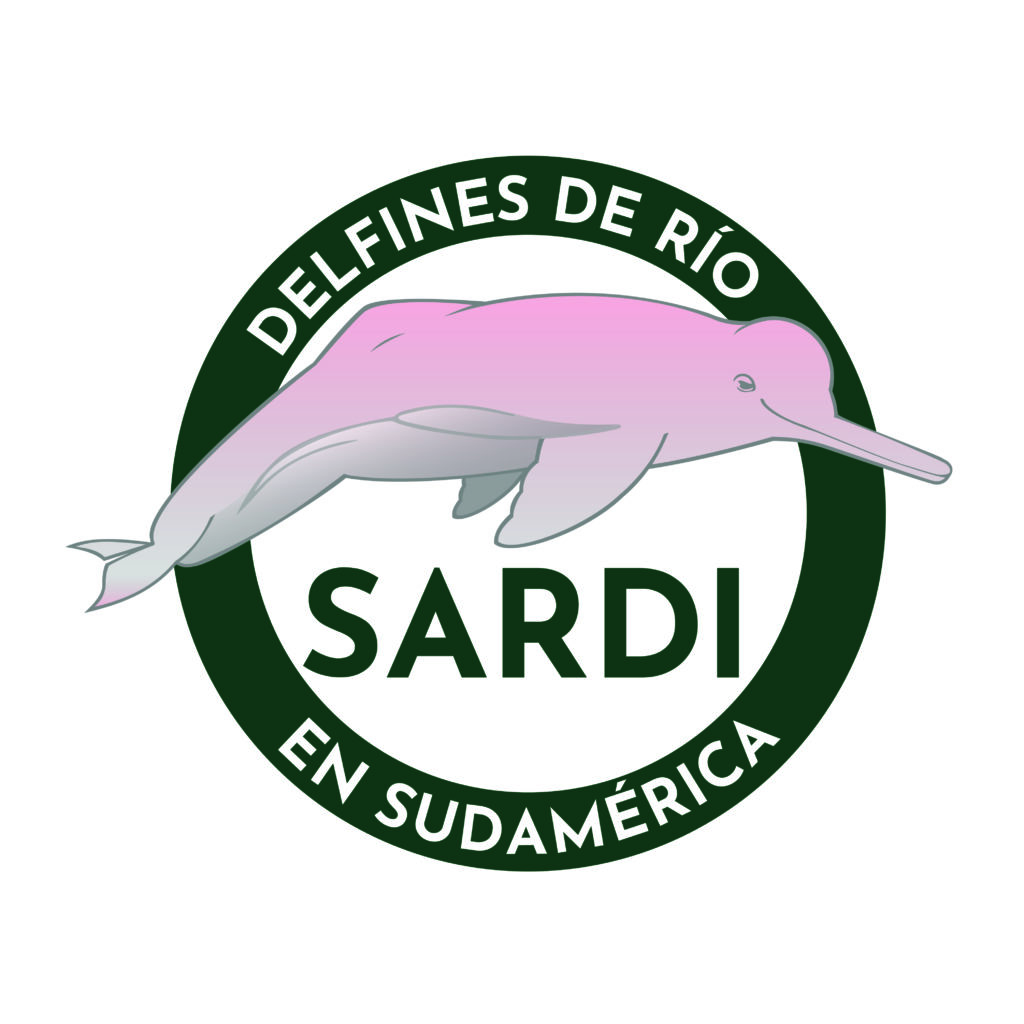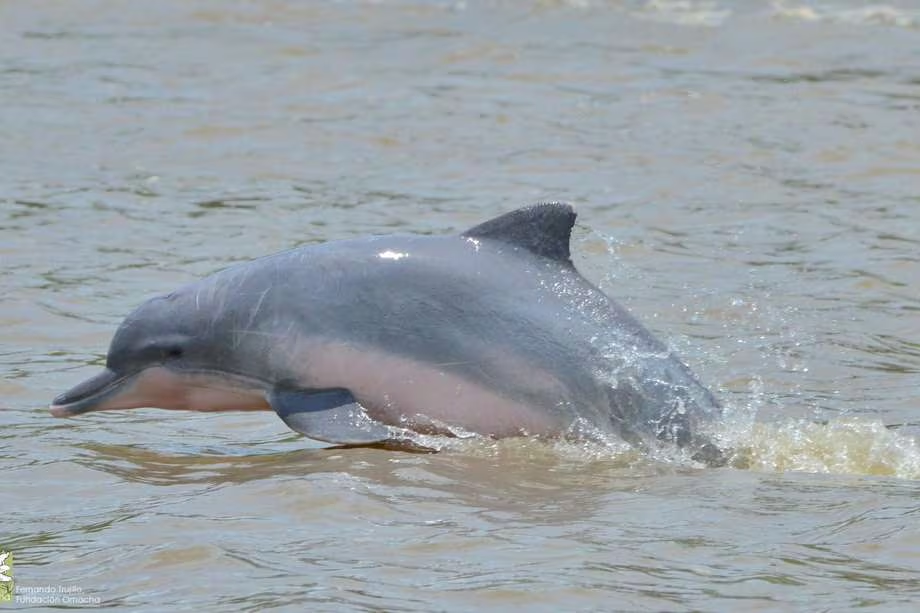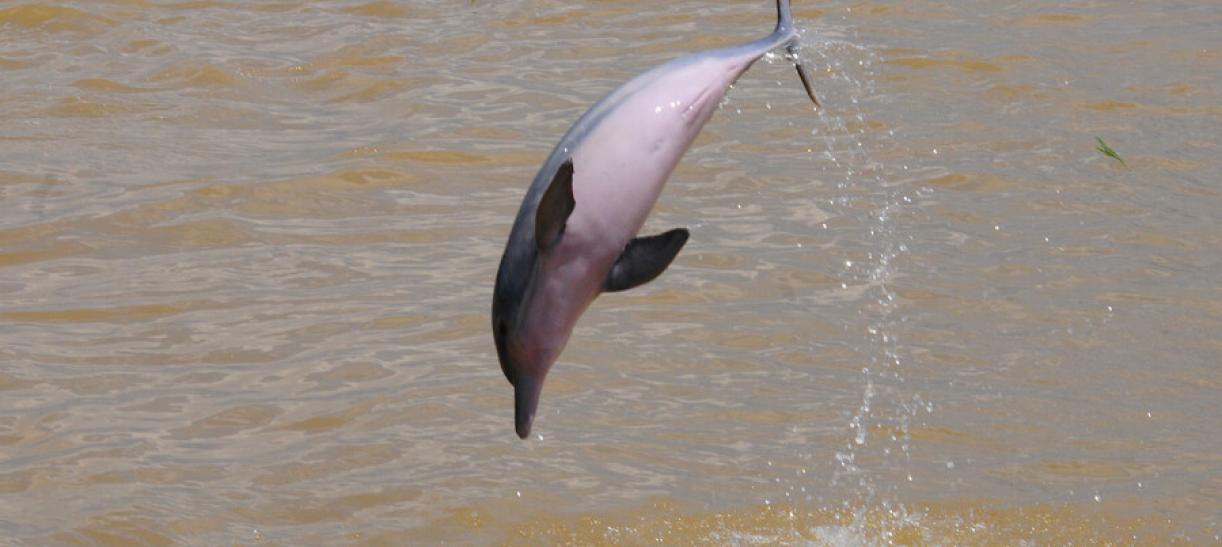Large mobilization of institutions and civil society is carried out to ensure effectiveness in emergency actions for Amazonian River dolphinsBy Mariana Gutiérrez, WWF-Brazil
After a series of extreme weather events in the Amazon, between September and November 2023, which triggered the deaths of at least 330 Amazon river dolphins and tucuxis, a large team of experts from government institutions, civil society organizations, professionals, local communities and volunteers mobilized in Tefé and Coari, Amazonas, to carry out monitoring, research and act efficiently to assist in crisis management.
On the 9th and 10th of last April, the “Workshop on Alignment and Lessons Learned from the Dolphin Emergency: Monitoring, Preparedness and Emergency Responses” was held in order to develop measures based on the lessons learned from the emergency response that was implemented last year, in order to reduce the impacts on the population of dolphins and other species such as manatees and their ecosystems. The event was hosted at the National Center for Research and Conservation of Amazonian Biodiversity (CEPAM), of the Chico Mendes Institute for Biodiversity Conservation (ICMBio), located at the Federal University of Amazonas (UFAM), in the city of Manaus (AM).
There are many efforts being made by several organizations that, during the Workshop, addressed the analysis of the actions carried out through the Incident Command (IC) led by the Coordination of Climate Emergencies and Epizootics of ICMBio, as well as the diagnoses and scientific research to understand the most strategic way to act in other possible scenarios. For Ayan Fleischmann, leader of the Research Group on Geosciences and Environmental Dynamics in the Amazon, of the Mamirauá Sustainable Development Institute, “every emergency action and every management of a species requires resources and data that have to be based on science, on scientific data and that is where the great role of us scientists and researchers in helping this type of crisis comes in”.
It was exactly these learnings that led the Mamirauá Institute to monitor in real time the ecosystems and the factors that can influence the environment of the species, such as water temperature, river flow, rain, solar radiation and wind, which together are interfering variables in the ecosystem of sentinel species such as the Amazon river dolphin (Inia geoffrensis) and the tucuxi (Sotalia fluviatilis). They can indicate the imbalance that an ecosystem can have by demonstrating stressful behavior, and that can be a warning for all of us.
The drought in the Amazon is related to the temperature increase in the North Atlantic Tropical that continues to persist and potentiated the effects of the El Niño phenomenon in 2023. Among the causes of the warming of the waters of lakes Tefé and Coari, which has been pointed out as one of the main factors for the great mortality of animals, are the increase in solar radiation, due to the lack of cloud cover, which led to the abnormal heating of the waters of rivers and lakes.
According to Miriam Marmontel, leader of the Amazonian Aquatic Mammal Research Group at the Mamirauá Institute, environmental and biological research at Lake Tefé was already being carried out in Amazonian conservation units and by expanding them to these lakes can result in a knowledge base for the prevention of tragedies such as the one that happened last year.
She also points out that the communities were essential in detecting the emergency crisis with the porpoises: “they also help us to understand what happened. The first warning came from the society of Tefé, from local residents who know that we work with dolphins and warned – look, the lake has a great death of dolphins, an unusual thing for us – and they noticed it.” The engagement of these communities is very important for the monitoring of species and their ecosystems.
There are expectations among organizations that from this Workshop it will be possible to be better prepared for the next extreme drought events, and for that it is necessary to formalize and structure the alliance between the organizations by defining the roles for each one. Continuing the process, a survey is being carried out of potential actors who can contribute to the Incident Command through operations, planning, logistics, finance, donations and publicization of information.
In addition to the Incident Command (IC), which is activated through an emergency protocol by ICMBio, there is the National Action Plan for the Conservation of Endangered Amazonian Aquatic Mammals (PAN Amazonian Aquatic Mammals), built by several experts on the subject and other actors and which aims to reduce the pressures of human action and increase knowledge about these species.
The emergency actions derived from the extreme weather events of 2023 were discussed in the PAN, as explained by Ingrid Oberg, environmental analyst at ICMBio and representative of the National Center for Research and Conservation of Aquatic Mammals (CMA): “carrying out this Workshop to make an emergency planning due to the incident that occurred with the death of porpoises is a new action included this year in the PAN and today begins the execution of this action with this emergency planning that will continue”.
Among the species contemplated in the PAN Amazonian Aquatic Mammals are the Amazon river dolphin (Inia geoffrensis), the Amazonian manatee (Trichechus inunguis), the giant otter (Pteronura brasiliensis), the tucuxi (Sotalia fluviatilis), the Neotropical otter (Lontra longicaudis) and the Araguaian river dolphin (Inia araguaiaensis), all of them under different degrees of threat.
The ongoing actions already indicate an expectation of improvement in preventive actions for the next drought in the Amazon. Mariana Paschoalini Frias, conservation analyst at WWF-Brazil, praises:
“So for us to prevent it, we need to study the scenario, count on the collaboration of all actors and even those who were not involved during the emergency, but who are potential collaborators, and leave with measures, mitigation protocols, preparation, rescue before, during and after an emergency”.
Among the participants of the Workshop were several government sectors, National Center for Research and Conservation of Aquatic Mammals (CMA), National Center for Research and Conservation of Amazonian Biodiversity (CEPAM) and Coordination of Climate Emergencies and Epizootics, General Coordination of Environmental Emergencies of ICMBio, Brazilian Institute of the Environment of Renewable Natural Resources (IBAMA), Ministry of Environment and Climate Change (MMA), Institute of Environmental Protection of Amazonas (IPAAM), National Center for Monitoring and Alerts of Natural Disasters (CEMADEN), Geological Service of Brazil (SGB), Oswaldo Cruz Foundation – Leônidas and Maria Deane Institute (IDLM/Fiocruz), Civil Defense of Amazonas.
From civil society, National Marine Mammal Foundation (NMMF), Association of Friends of Manatees (AMPA), R3 Animal Association (R3), Sea Shepherd Brazil, Wildlife Conservation Society (WCS), Aquatic Mammals Foundation (FMA), Association for Research and Preservation of Aquatic Ecosystems (Aquasis), YAQU PACHA, WWF-Brazil.
From scientific research institutions, the Mamirauá Institute for Sustainable Development (IDSM), Laboratory of Comparative Pathology of Wild Animals of the University of São Paulo (LAPCOM/USP), National Institute for Amazon Research (INPA); from educational institutions, Evangelical University of Goiás (UniEvangélica), Federal University of Amazonas (UFAM), Military College of Tocantins; and from the business sector, AMBIPAR, Aiuká Environmental Consulting, Aqua Viridi Environmental Consulting.
The workshop was facilitated by WWF-Brazil as an articulator and member of the Incident Command established and articulator of actions of the Amazonian Aquatic Mammals PAN.





